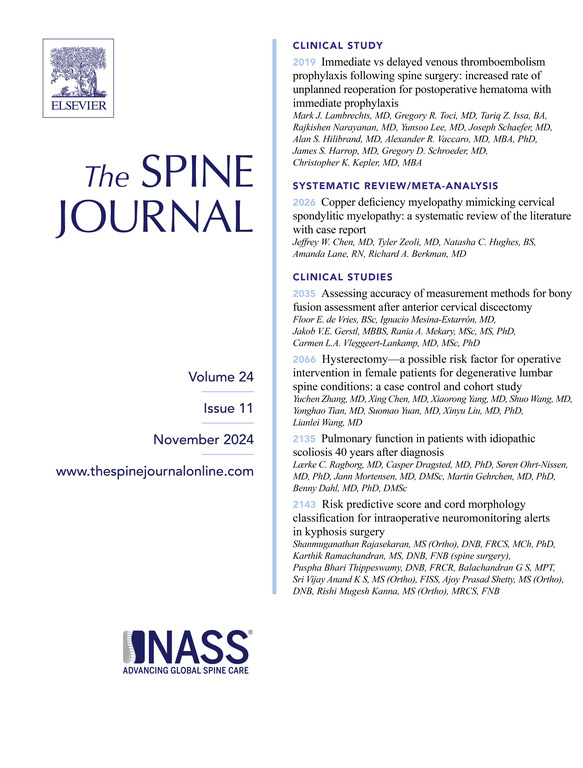平民弹道脊髓损伤与钝器创伤:临床特征、管理和结果的比较分析。
IF 4.9
1区 医学
Q1 CLINICAL NEUROLOGY
引用次数: 0
摘要
背景情况:目前还没有针对脊柱平民枪伤(GSW)的管理指南,患者管理通常依赖于从钝性创伤(BT)中得出的算法。然而,GSW 或钝性创伤机制导致的脊髓损伤在临床表现、管理和预后方面可能存在显著差异。为确保改进循证治疗,我们需要了解决定脊柱GSW结果的民用特征,并确定其与已被充分研究的BT的不同之处:设计:回顾性单中心分析:患者样本:2003-2022年间,因GSW或BT导致脊髓损伤而入住一级创伤中心的1939名患者:主要结果指标为美国脊髓损伤协会(ASIA)运动评分的进展情况:方法:比较临床特征,然后进行年龄匹配分析:在 1939 名脊髓损伤患者中,566 人被纳入 GSW 组,1373 人被纳入 BT 组。大多数 GSW 组患者为男性(94.9% GSW vs. 83.5% BT; p结论:据我们所知,这是平民弹道脊髓损伤与 BT 相比最大的单中心数据集。GSW 受影响的多为年轻男性,与 BT 相比,在死亡率相似的情况下,GSW 造成的神经系统损伤明显更严重、更完全。尽管如此,目前的数据表明,GSW 组截瘫患者和不完全损伤患者的神经功能改善潜力更大。与 BT 相比,GSW 导致的脊髓损伤患者接受手术的频率较低。手术治疗的 GSW 病例主要涉及腰椎。这项研究揭示了GSW和BT导致的脊髓损伤之间的差异。在临床应用中,这意味着基于 BT 的指南可能无法直接应用于民用弹道脊髓损伤。本文章由计算机程序翻译,如有差异,请以英文原文为准。
Civilian ballistic spinal cord injuries versus blunt trauma: comparative analysis of clinical characteristics, management, and outcomes
BACKGROUND CONTEXT
There are no current guidelines for the management of civilian gunshot wound injuries (GSW) to the spine and patient management often relies on algorithms derived from blunt trauma (BT). However, spinal cord injury due to GSW or blunt trauma mechanism may have significantly different clinical presentation, management, and outcomes. To ensure improved and evidence-based treatment, we need to understand the outcome determining characteristics of civilian GSW to the spine and identify the differences to the well-studied BT.
PURPOSE
The aim of this study was to compare clinical characteristics, neurological deficit, management strategies, and mortality associated with GSW to the spine versus BT.
DESIGN
Retrospective single-center analysis.
PATIENT SAMPLE
One thousand nine hundred thirty-nine unique patients admitted to a level 1 trauma center with spinal cord injuries due to GSW or BT between the years 2003–2022.
OUTCOME MEASURES
Primary outcome measure was the progression in American Spinal Injury Association (ASIA) motor score.
METHODS
Clinical characteristics were compared followed by age-matched analysis (<45years) of neurological injury, the need for surgery, neurological outcomes and mortality. Stratification by neurological injury allowed for more homogenous subgroups for outcome analysis.
RESULTS
Of the 1939 patients with spinal cord injury, 566 were included in GSW group, and 1373 patients in BT group. Most patients in the GSW group were males (94.9% GSW vs 83.5% BT; p<.001) and younger (28.2 (range 13-62) years vs 37.9, (range 12-91) years, p<.001). The age-matched dataset comprised 1536 patients, with 540 in GSW group, and 996 in BT group. There were significantly more complete neurological injuries at admission in GSW group compared with BT (63.5% GSW vs 34.4% BT, p<.001). The ASIA motor Score at admission was significantly lower in GSW group (p<.001), and changed without significant difference between the groups from admission to discharge (p<.001, p=.222). Subgroup analysis based on spinal cord injury showed that a higher proportion of patients with incomplete injuries improved neurologically, opposed to complete injuries, with significantly more patients improving in GSW group compared to BT (incomplete 58.9% GSW vs 44.3% BT, p<.001). Likewise, a higher proportion of paraplegic patients improved, opposed to quadriplegic patients, and in the paraplegic subgroup GSW patients improved rather than BT (paraplegic 65.1% GSW vs 35.3%BT, p<.001). In GSW group significantly less patients were managed operatively compared to BT group (12.2% GSW vs 76.8% BT, p<.001). Most surgeries were bullet removals (81,4%) and involved the lumbar spine: 38.6% lumbar surgeries (of all GSW surgeries) and 31.4% surgery rate of all lumbar GSW patients. There was no significant difference in ASIA motor and sensory score improvement between patients who underwent surgery for bullet removal compared to nonoperatively managed patients in GSW group (p=.199). The incidence rate of surgery showed a downwards trend over the study period. GSW group showed significantly less complications than BT group (22.8% GSW vs 27.0% BT, p<.001). There was no significant difference in mortality rates (p≥.289).
CONCLUSION
To our knowledge, this is the largest single-center dataset of civilian ballistic spinal cord injuries compared to BT. GSW affect mostly young males and result in significantly more severe, complete neurologic injuries compared with BT at similar mortality rates. Nevertheless, the present data suggest a greater potential for neurological improvement for paraplegic patients and incomplete injuries in GSW group. Patients with spinal cord injuries due to GSW undergo surgery less frequently compared to BT. Operated GSW cases primarily involved the lumbar spine. This study revealed differences between spinal cord injuries due to GSW and BT. In clinical application, this means that guidelines based on BT may not directly be transferable to civilian ballistic spinal cord injuries.
求助全文
通过发布文献求助,成功后即可免费获取论文全文。
去求助
来源期刊

Spine Journal
医学-临床神经学
CiteScore
8.20
自引率
6.70%
发文量
680
审稿时长
13.1 weeks
期刊介绍:
The Spine Journal, the official journal of the North American Spine Society, is an international and multidisciplinary journal that publishes original, peer-reviewed articles on research and treatment related to the spine and spine care, including basic science and clinical investigations. It is a condition of publication that manuscripts submitted to The Spine Journal have not been published, and will not be simultaneously submitted or published elsewhere. The Spine Journal also publishes major reviews of specific topics by acknowledged authorities, technical notes, teaching editorials, and other special features, Letters to the Editor-in-Chief are encouraged.
 求助内容:
求助内容: 应助结果提醒方式:
应助结果提醒方式:


